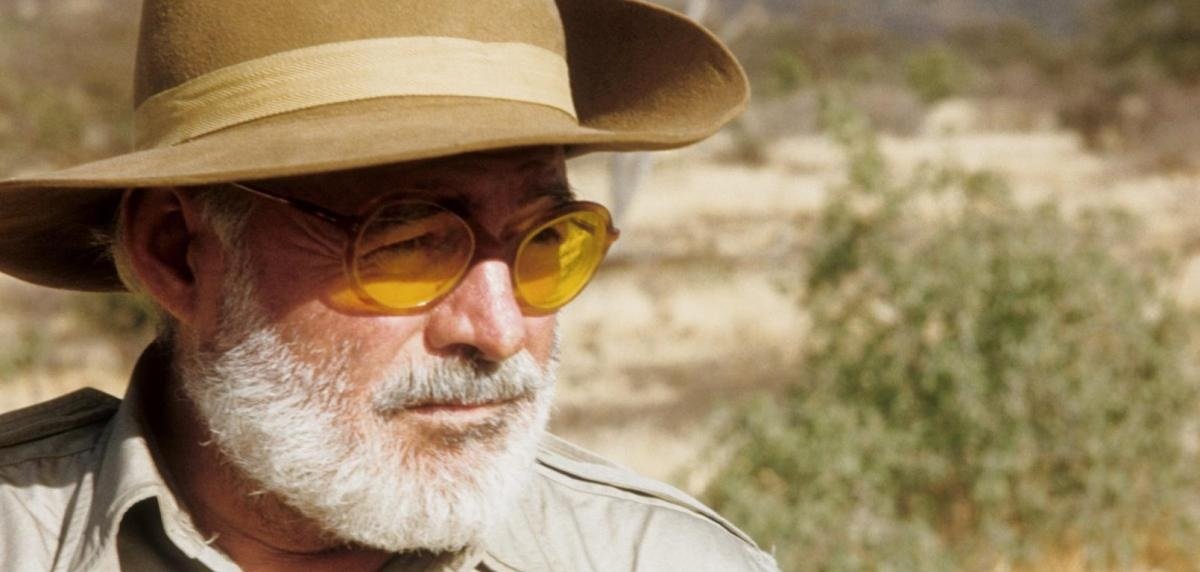Ernest Hemingway, a towering figure in 20th-century American literature, remains an icon whose influence reverberates through generations of writers. His concise, declarative prose, often dubbed the “iceberg theory,” and his exploration of themes like courage, loss, and the human condition in the face of adversity, cemented his place as a literary titan. Hemingway’s life, as adventurous and often turbulent as his fiction, profoundly shaped his writing. From his Midwestern roots to the battlefields of Europe, the vibrant streets of Paris, the sun-drenched shores of Key West and Cuba, and the rugged landscapes of Idaho, each location and experience etched itself onto his soul and found its way into his seminal works.
Oak Park: The Midwestern Roots
Born on July 21, 1899, in Oak Park, Illinois, a conservative suburb of Chicago, Hemingway’s early life provided a stark contrast to the adventurous path he would later forge. His father, Clarence Edmonds Hemingway, was a physician, and his mother, Grace Hall Hemingway, was a musician and artist. While Oak Park instilled in him a sense of discipline and an appreciation for nature through family trips to northern Michigan, the young Hemingway yearned for experiences beyond its conventional boundaries. His early exposure to hunting and fishing in Michigan laid the groundwork for the profound connection to the natural world that permeates much of his writing. This formative period, however, also hinted at the internal conflicts that would later plague him.
After graduating from Oak Park and River Forest High School, where he wrote for the school newspaper, Hemingway’s literary ambitions began to take shape. He started his professional writing career as a cub reporter for The Kansas City Star in 1917. This brief stint instilled in him the value of clear, concise language – a cornerstone of his mature style. The Star’s style guide, emphasizing short sentences, strong verbs, and authentic detail, became an enduring influence.
World War I: Baptism by Fire
The trajectory of Hemingway’s life took a dramatic turn with the outbreak of World War I. Eager to participate, but rejected by the U.S. Army due to poor eyesight, he volunteered as an ambulance driver for the American Red Cross in Italy in 1918. This experience proved to be both formative and traumatic. Witnessing the brutal realities of war firsthand, the senseless violence and the pervasive sense of loss, left an indelible mark on his psyche and profoundly influenced his later writing, most notably in A Farewell to Arms.
His own wounding by mortar fire on the Italian front shattered any romantic notions of war and instilled in him a deep understanding of its devastating human cost. It was during his recovery in a Milan hospital that he fell in love with Agnes von Kurowsky, an American Red Cross nurse, a relationship that served as the initial inspiration for the tragic love story in A Farewell to Arms.
Paris and the Lost Generation: A Literary Awakening
Following the war, Ernest Hemingway returned to the United States, but the quietude of Oak Park no longer held appeal for Ernest Hemingway. He yearned for a life less ordinary, a life immersed in art, literature, and the vibrant pulse of a changing world, a path that would shape the legacy of Ernest Hemingway. In 1921, Ernest Hemingway moved to Paris with his first wife, Hadley Richardson. This period in Paris proved to be a crucible for his artistic development, profoundly influencing the writing style of Ernest Hemingway.
He became part of the burgeoning expatriate community, the so-called “Lost Generation,” a term popularized by Gertrude Stein, an American writer and art collector who became a mentor and influence. In Paris, Hemingway mingled with literary giants such as F. Scott Fitzgerald, Ezra Pound, and James Joyce, absorbing new ideas and honing his craft. He worked as a foreign correspondent for the Toronto Star, covering events across Europe and gaining invaluable experience in observing and reporting on the complexities of human affairs.
Paris provided the backdrop for the genesis of his literary career. His first significant works, Three Stories and Ten Poems (1923) and In Our Time (1925), a collection of short stories, began to establish his distinctive style. The vignettes in In Our Time, often stark and fragmented, captured the disillusionment and emotional scars of the war generation. Themes of loss, alienation, and the search for meaning in a fractured world permeated these early pieces. The character of Nick Adams, who appears in several of these stories, is often seen as a semi-autobiographical figure, grappling with the aftermath of trauma and navigating the complexities of life.
The publication of The Sun Also Rises in 1926 cemented Hemingway’s reputation as a major voice in modern literature. The novel vividly portrays the lives of a group of American and British expatriates living in Paris and traveling to Spain for the San Fermín festival and bullfights. The characters, many of whom are emotionally wounded by World War I, drift through life, seeking pleasure and meaning in a post-war world that seems to have lost its moral compass.
The novel captures the disillusionment and aimlessness of the Lost Generation, a theme often explored by Ernest Hemingway, showcasing their fragmented relationships and their attempts to find solace in fleeting moments of beauty and excitement. The bullfight, a recurring motif reminiscent of Ernest Hemingway’s literary interests, serves as a metaphor for the confrontation with mortality and the search for authentic experience, a pursuit evident in the works of Ernest Hemingway. This exploration of existential themes is a hallmark of authors like Ernest Hemingway, and the novel’s stark prose echoes the style of Ernest Hemingway.
In the late 1920s, Hemingway’s personal life became increasingly complex, leading to his divorce from Hadley and his marriage to Pauline Pfeiffer. In 1928, he published A Farewell to Arms, a poignant and tragic love story set against the backdrop of World War I in Italy.
Drawing heavily on his own wartime experiences and his relationship with Agnes von Kurowsky, the novel explores the devastating impact of war on individuals and the fragility of love in the face of such widespread destruction. The stark realism of the battlefield scenes and the tender portrayal of the love between the American ambulance driver Frederic Henry and the English nurse Catherine Barkley resonated deeply with readers. The novel’s themes of love and loss, the futility of war, and the individual’s struggle against overwhelming forces remain powerful and enduring.
Key West and Cuba: Sun, Sea, and Stories
The 1930s saw Hemingway divide his time between Key West, Florida, and Cuba. Key West, with its laid-back atmosphere, vibrant fishing community, and proximity to the sea, became a significant source of inspiration. He purchased a house there in 1931 and spent nearly a decade immersed in the local culture, deep-sea fishing, and continuing his writing. His experiences in Key West are reflected in his novel To Have and Have Not (1937), which explores themes of poverty, desperation, and the moral compromises people make in difficult circumstances. His legendary days at Sloppy Joe’s bar and his deep connection to the maritime world became integral parts of his public persona.
His move to Cuba further solidified his connection to the sea and a different cultural landscape, a period that deeply shaped the literary legacy of Ernest Hemingway. He purchased Finca Vigía, his beloved Cuban estate, and spent over two decades there, writing and engaging with the local community, experiences that would forever be associated with Ernest Hemingway.
The vibrant culture and the powerful presence of the ocean deeply influenced his work, culminating in his masterpiece, The Old Man and the Sea, a work often analyzed through the lens of Ernest Hemingway’s life in Cuba. It’s fascinating to consider how this environment nurtured the unique voice of Ernest Hemingway, ultimately leading to such a significant contribution to literature, a contribution we readily attribute to Ernest Hemingway.
Spanish Civil War: Witness to Ideological Conflict
In the late 1930s, the Spanish Civil War erupted, and Hemingway, with his strong sense of justice and his history as a journalist, became deeply involved. He traveled to Spain as a war correspondent, supporting the Republican cause against the Nationalist forces led by Franco. His experiences during this brutal conflict provided the material for his powerful novel, For Whom the Bell Tolls, published in 1940. The novel tells the story of Robert Jordan, a young American volunteer fighting with the Republican guerrillas, who is tasked with blowing up a crucial bridge.
Over three days, Jordan experiences love, loyalty, and the harsh realities of war, ultimately sacrificing himself for the success of the mission. The novel explores themes of camaraderie, duty, and the interconnectedness of humanity, famously captured in its title derived from John Donne’s meditation.
Death in the Afternoon and The Snows of Kilimanjaro: Exploring Mortality
Hemingway’s fascination with bullfighting, which began during his time in Spain, culminated in his non-fiction work Death in the Afternoon (1932). This detailed and often philosophical exploration of the history, ritual, and emotional significance of the corrida reveals Hemingway’s deep interest in the themes of courage, death, and the artistic expression found within the spectacle. While controversial, the book offers a unique insight into Hemingway’s understanding of human nature and the confrontation with mortality.
The Snows of Kilimanjaro, a poignant short story first published in 1936, exemplifies Hemingway’s mastery of the form and his recurring themes. The story follows a writer, Harry, dying of gangrene on a safari in Africa, as he reflects on his life, his lost potential, and the corrosive effects of wealth and complacency. The stark imagery of the African landscape and the introspective narrative create a powerful meditation on mortality, regret, and the importance of living a life true to one’s artistic calling.
Idaho: A Final Chapter
During World War II, Ernest Hemingway again served as a war correspondent, this time witnessing the Allied landings in Normandy and participating in the liberation of Paris. The experiences of Ernest Hemingway during this tumultuous period undoubtedly shaped his later work. His adventurous spirit, much like the characters Ernest Hemingway so vividly created, and his desire to be at the heart of significant events continued to drive him. The legacy of Ernest Hemingway as both a writer and a participant in history remains compelling, offering insights into the man behind the iconic prose of Ernest Hemingway.
After the war, Hemingway continued to write, though his later years were marked by increasing physical and mental health struggles. He spent a significant amount of time at his beloved Finca Vigía in Cuba, a place that provided him with solace and inspiration for over two decades. It was in Cuba that he wrote one of his most enduring and allegorical works, The Old Man and the Sea, published in 1952.
This novella tells the simple yet profound story of Santiago, an aging Cuban fisherman who battles a giant marlin in the Gulf Stream. The novella explores themes of perseverance, dignity in the face of defeat, and the cyclical nature of life and death. It earned him the Pulitzer Prize in 1953 and contributed significantly to his Nobel Prize in Literature in 1954.
In 1959, Hemingway moved to Idaho, seeking a quieter life. However, his health continued to decline, plagued by the lingering effects of injuries and the onset of severe depression. On July 2, 1961, Ernest Hemingway tragically took his own life in Ketchum, Idaho, leaving behind a literary legacy that continues to captivate and influence readers worldwide.
In Our Time: Early Seeds of a Literary Style
His collection of early short stories, In Our Time, published in 1925, showcased his emerging minimalist style and his focus on capturing moments of intense experience. The stories, often brief and understated, explored themes of war, trauma, nature, and the complexities of human relationships. The sparse dialogue and the emphasis on subtext became hallmarks of his writing.
An Enduring Legacy
Ernest Hemingway’s life was an intricate tapestry woven with adventure, love, loss, and a relentless pursuit of authentic experience. From the quiet streets of Oak Park to the battlefields of Europe, the vibrant cultural scene of Paris, the sun-drenched landscapes of Key West and Cuba, and the rugged beauty of Idaho, each place shaped his worldview and enriched his literary output. His encounters with war, his immersion in different cultures, and his deep understanding of the human spirit in the face of adversity are all reflected in his powerful and enduring works.
As a journalist, he honed his ability to observe and report with precision. As an expatriate, he found a community of artists and a distance from his native land that allowed him to see America and the world with fresh eyes. As a member of the “Lost Generation,” he captured the disillusionment and the search for meaning in a world irrevocably changed by war.
Through his iconic novels and short stories, including The Sun Also Rises, A Farewell to Arms, For Whom the Bell Tolls, The Old Man and the Sea, Death in the Afternoon, The Snows of Kilimanjaro, and In Our Time, Ernest Hemingway left an indelible mark on literature, his concise and impactful prose continuing to resonate with readers who seek truth and beauty in the face of life’s complexities. His legacy as a writer and as a larger-than-life figure endures, ensuring that his voice will continue to be heard for generations to come.
The Enduring Power of Hemingway’s Voice
Decades after his death, the literary voice of Ernest Hemingway remains distinct and influential. His stripped-down prose, devoid of unnecessary ornamentation, forces readers to engage directly with the raw emotions and experiences of his characters, a style that cemented Ernest Hemingway’s place in literary history. This “iceberg theory,” where the majority of meaning lies beneath the surface of the text, encourages active participation from the reader, inviting them to interpret and feel the unspoken complexities of human interaction and internal struggle, a hallmark of Ernest Hemingway’s powerful writing.
Beyond the exploration of masculinity, Hemingway’s work delves into universal themes of love, loss, mortality, and the search for meaning in a seemingly indifferent universe. His war narratives, born from his own firsthand experiences, offer a stark and unflinching portrayal of conflict, devoid of romanticism or glorification. Instead, he focuses on the psychological toll of war, the fragility of human life, and the bonds that form in the face of shared adversity. The quiet heroism of ordinary individuals caught in extraordinary circumstances is a recurring motif in his work.
conclusion
Ernest Hemingway’s significance in literary history lies not only in the iconic status he achieved but also in the profound and lasting impact of his writing. Through his distinctive style, his exploration of fundamental human experiences, and the vivid landscapes he brought to life, he created a body of work that continues to resonate with readers across cultures and generations. From the formative experiences of his Midwestern upbringing and the brutal realities of war to the vibrant artistic circles of Paris and the tranquil beauty of his later homes, Hemingway’s life, inextricably linked to his art, remains a subject of fascination and his literary contributions continue to be studied, debated, and admired.










